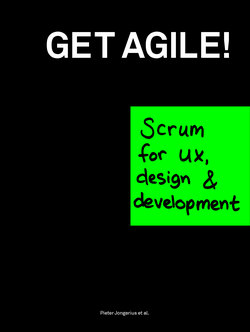Читать книгу Get Agile - Pieter Jongerius - Страница 8
На сайте Литреса книга снята с продажи.
ОглавлениеAgile design & development, and Scrum, mean the return of common sense. In Agile, future quality is more important than past decisions. Trust is more important than documentation. Freedom in exchange for commitment.
With Scrum, you as the design & development team invite the client into your territory. Together you will develop the insights and products which will help his business grow. You will be open to his ideas and you will be required to expose many different facets of yourself. Together you will overcome disappointments and celebrate victories. Selling Scrum is selling an experience. Scrum is never boring!
Due to the set rules in Scrum projects, dilemmas come to light at top speed: break off or give a bit more time? Discuss now or let things simmer? Dig into it or make assumptions? This requires the very best from teams. In this book the main steps and issues are discussed, and team members tell us about their experience:
2. What, Why, When - This chapter discusses the history and philosophy of Scrum, the reasons for applying it, but also possible reasons why not to use Scrum.
3. How to set up a project - If you’ve decided to scrum, you will want to know what the team has to look like, how much time it costs, what the structure of Scrum projects is and what the requirements are in terms of organization and facilities.
4. Sprint 0 - This first special stage provides base and defines direction. How do you get to grips with the assignment? How do you get the right ambition in the team? The team will start ideation, do basic design and set up technical architecture. It will divide the project into manageable chunks.
5. Go sprint! - This is the real deal. Kick-offs, progress monitoring, evaluations and more. This chapter focuses on the daily practice of the Scrum.
6. Sprinting Secrets - Now that the basics of Scrum are covered, we can elaborate on some of our real secrets: how can you simultaneously design and develop? How do you maintain or enhance your creativity? How do you deal with difficult product owners?
7. Troubleshooting - Like in any good handbook there is a problem solving section. The most common problems are briefly described and we offer possible solutions.
8. Meet the Team - Eight team members from different disciplines (director, interaction designer, visual designer, developer, Scrum Master, project manager, client) each answer important questions about their role, how Scrum has helped them, about the dangers, etc. We offer links to five minute video interviews online.
9. Glossary - Yes, Scrum uses a lot of slang terms. Here are the most important ones.
Scrum is one of the most difficult processes to master. It all comes down to the ability to improvise, craftmanship, and authentic hard-won team building (so not the semi-survival blindfolded paintball-on-a-ledge surrogate teambuilding that you can buy just anywhere). Take this handbook with you wherever you scrum, you will need it!
In the next chapter we will start with the first step: deciding whether to use Scrum or not.
